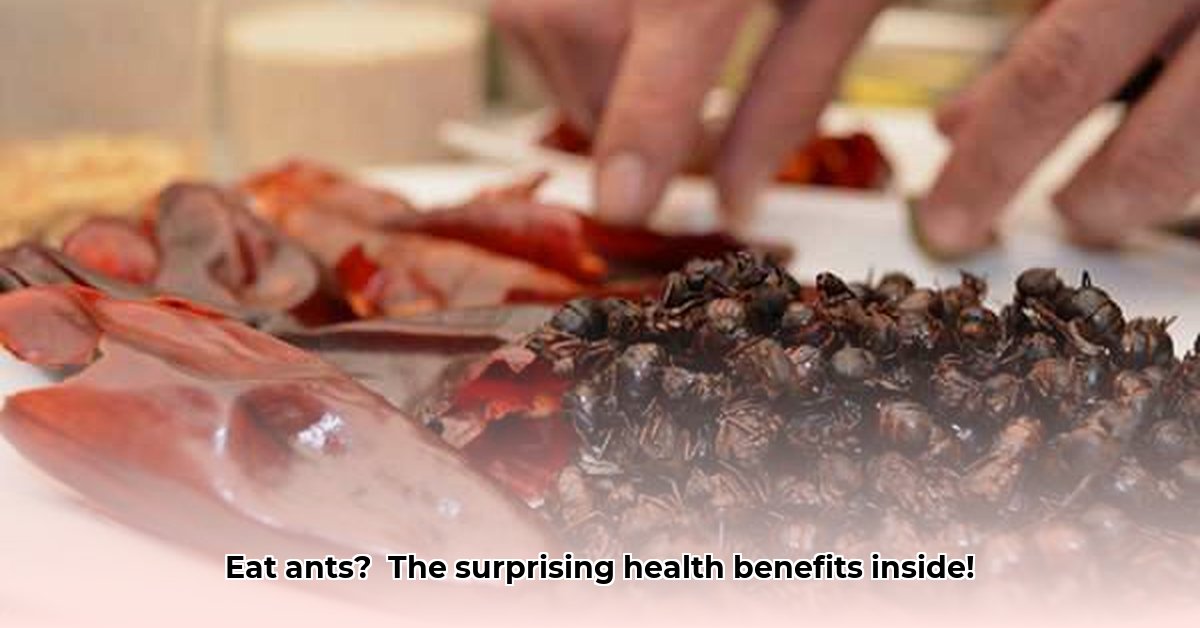Ever thought about munching on an ant? Sounds weird, right? But believe it or not, people have been eating ants for ages! And with all the talk about food shortages and protecting the planet, ants are getting a second look as a possible superfood. For more on healthy eating habits, check out this article on [eating posture](https://chaztin.com/is-it-healthy-to-eat-standing-up/). Are they really good for you? Are they safe to eat? And could farming ants actually be better for the environment than raising cows or pigs? This article dives into all that, exploring the surprisingly good nutritional side of ants, the environmental benefits of eating them, and what you need to know to eat them safely. We’ll explore everything from how nutritious ants are to the future of ant farming – providing a clear, easy-to-understand look at this unusual but potentially important food source.
The Buzz About Bugs: Why Are We Talking About Eating Ants?
The world’s growing population is putting a strain on our food resources. Experts are searching for more sustainable and nutritious food sources, and insects, including ants, are emerging as a viable option. Entomophagy, or insect-eating, isn’t new. It’s practiced in many cultures around the world. But it’s gaining traction in Western societies as people look for more environmentally friendly and protein-rich diets. Ants, in particular, are drawing attention because they’re relatively easy to harvest or farm, and they offer a surprising range of nutrients.
Are Ants Healthy to Eat and the Benefits They Offer?
Let’s talk about ants – not as pests, but as a potential food source. It might sound a little strange at first, but hear me out. For centuries, many cultures around the globe have incorporated ants into their diets, savoring them as a tasty and nutritious treat. But are these six-legged creatures truly a healthy addition to our plates? The answer, as with most things, is a bit more complex than a simple yes or no. Is ant consumption a sustainable food source for the future when thinking about sustainable agriculture practices?
Nutritional Powerhouses: A Tiny Package of Big Benefits
So, are ants good for you? Yes, potentially. Depending on the type of ant and how they’re prepared, ants can be surprisingly nutritious. We’re talking a significant protein punch – some species boast protein levels comparable to beef or chicken! Think of this as a tiny insect delivering a macronutrient powerhouse. But it’s not just protein. Ants also offer a good dose of essential minerals like iron, zinc, and magnesium – crucial for a healthy body. Plus, there’s fiber, primarily in their exoskeletons (the hard outer shells), which is great for digestion. Weaver ant larvae and eggs, for example, offer about 7 grams of protein per 100 grams. Adult leaf-cutter ants can contain a whopping 42-53 grams of protein per 100 grams.
However, it’s important to remember that the nutritional content can differ greatly depending on the ant species. A weaver ant won’t have exactly the same nutritional profile as a leafcutter ant. The way you prepare the ants also affects their nutritional value. Cooking methods can change the nutrient levels, so this needs to be considered.
Eco-Friendly Eating: A Sustainable Choice for Insect Consumption?
Beyond their nutritional benefits, ants offer a fascinating perspective on sustainable food production. Traditional meat farming often comes with significant environmental baggage: large land use, high water consumption, and substantial greenhouse gas emissions. Ant farming, on the other hand, presents a much more environmentally friendly alternative. It requires considerably less land, water, and produces a much smaller carbon footprint. Insects in general have a high feed conversion efficiency, meaning they require less feed to gain weight compared to livestock. For example, crickets need 12 times less feed than cattle. Imagine enjoying a protein-rich meal while simultaneously reducing your impact on the planet – that’s the appeal of entomophagy (insect-eating).
Potential Pitfalls: Navigating the Risks of Eating Ants
Before you rush to the nearest anthill, let’s discuss the potential drawbacks. While ants offer many benefits, there are potential risks to be aware of. Some individuals might be allergic to chitin, a component of ant exoskeletons. There’s also the possibility of parasitic infections if the ants aren’t properly sourced and prepared. Specifically, the parasite Dicrocoelium dendriticum may infect humans who eat ants that contain metacercariae. However, cases of dicrocoeliosis are rare. And, of course, there’s the concern of contamination – pesticides or other harmful substances could potentially be present. Some ant species, like fire ants, are poisonous and should never be consumed. So careful selection and preparation are crucial for safe consumption.
Thorough cooking is essential to eliminate any potential parasites or harmful bacteria. Choosing suppliers who follow safe and sustainable harvesting practices is equally important. We need more research to completely understand any potential long-term health effects of regular ant consumption. There’s some evidence, for example, that chitin might be a food allergen for some people, while other studies suggest it could improve immune responses. The more we learn, the better we can understand how to incorporate ants safely and beneficially into our diets.
Sustainable Harvesting: Protecting Our Planet and Our Food Source for the Future
Sustainable harvesting is key to ensuring the long-term viability of ants as a food source. Unsustainable practices could decimate ant populations and damage the delicate balance of the ecosystems where they thrive. Responsible ant farming provides a controlled and managed approach, ensuring consistent availability while protecting the environment. Investment in research and development of ant farming techniques is necessary to optimize yields and minimize environmental impacts. It’s not just about eating the ants; it’s about creating a sustainable food system for the future.
The Regulatory Landscape: Evolving Guidelines for Food Safety
Current regulations surrounding edible insects, including ants, are still developing globally. The European Union, for example, has recently updated its regulations to allow specific insect species for human consumption, increasing their availability in the market. As interest and consumption grow, we can anticipate more comprehensive guidelines and standards to emerge. These regulations will be vital for assuring both food safety and responsible harvesting, promoting confidence in ant-based foods and encouraging market growth. What is the regulatory process for edible insects in countries where entomophagy is common?
A Balanced Perspective: Weighing the Pros and Cons of Consuming Ants
Are ants healthy to eat? The answer is a cautious “yes,” but with important caveats. Ants offer excellent nutritional benefits and a more sustainable protein source compared to traditional livestock, but potential risks – allergies, parasites, contamination – need careful consideration. The key to safely enjoying this unique food source lies in responsible consumption practices: choosing reputable suppliers, cooking thoroughly, and promoting sustainable harvesting techniques. The future of edible insects is promising, but informed choices and continued research are vital to ensure we reap the benefits while minimizing potential risks.
A Quick Reference Table:
| Aspect | Pros | Cons | Mitigation |
|---|---|---|---|
| Nutritional Value | High protein, essential minerals, fiber | Variable composition; depends on species and method | Select known, safe species; proper preparation crucial |
| Environmental Impact | Lower land use, water, greenhouse gas emissions | Potential for ecosystem disruption if unsustainable | Promote responsible farming and sustainable harvesting |
| Health Risks | Relatively low if handled correctly | Allergies (chitin), parasites, contamination risks | Thorough cooking, reputable sources, careful handling |
How to Safely Harvest and Prepare Edible Ants for Consumption
Key Takeaways:
- Ants offer a surprisingly nutritious and sustainable protein source.
- Not all ants are edible; proper species identification is crucial.
- Safe harvesting and preparation techniques minimize health risks.
- Sustainable ant farming practices are vital for long-term availability.
- Further research is needed to fully understand ant allergenicity and toxicity.
The Nutritional Powerhouse: Are Edible Ants a Superfood?
Believe it or not, ants are nutritional powerhouses! Many species boast impressive protein levels, comparable to or exceeding beef. They also provide essential minerals like iron, zinc, calcium, and magnesium. Think of them as tiny, six-legged nutrient packs. But remember, the nutritional value varies significantly depending on the species, their life stage (larvae, pupae, adults), and how you prepare them.
Environmental Champions: A Sustainable Solution for Meat Production?
Ant farming presents a compelling environmental alternative to traditional livestock. It requires far less land, water, and feed. Greenhouse gas emissions are significantly lower. It’s a small-scale solution with big sustainability benefits. Insects convert feed into protein with remarkable efficiency, requiring far less land, water, and food resources. It’s almost like nature’s perfect little protein factory! However, sustainable harvesting strategies are crucial to ensure we don’t deplete ant populations.
Potential Risks: Navigating the Challenges of Harvesting
While promising, consuming ants does present some challenges. Some ant species are toxic, causing allergic reactions or other health problems. Some ants, like fire ants and jack jumper ants, have organs that produce poison. While the poison is usually deactivated in your digestive tract, there’s a risk of stings in your mouth or esophagus, which may cause fatal allergic reactions. Others may carry parasites or contaminants, especially if harvested from polluted environments. How to safely harvest and prepare edible ants for consumption is, therefore, very important. This includes careful species identification and thorough cooking. Always source from reputable providers to minimize risk. It’s vital to prioritize careful sourcing
- How Glass Bento Box Containers Make Meal Prep Easier - December 18, 2025
- Why Glass Boxes for Lunch Are Trending for Meal Prep - December 17, 2025
- Bento Box Glass Offers Practical, Eco-Friendly Meal Storage - December 16, 2025










